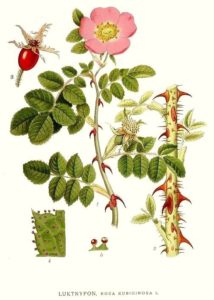Rose hip seed oil: why I like it and why we use it in so many products
Just as I explained in my post on avocado oil, the way to choose an oil for skin care is to look at its fatty acid composition. This is because we need certain fatty acids that are paramount for our skin health but, unfortunately, we can’t make them. They are essential fatty acids because we need to ingest them and apply them topically if we want our body to work the way it should.
 Figure: Rosa rubiginosa L.
Figure: Rosa rubiginosa L.
What is special about rosehip oil? While others may talk about its origin, I prefer to write about fatty acid composition. The rosehip is the fruit of the rose, and the oil is expressed from the seeds. Its composition will depend on many factors: the variety (genetics), conditions of growth and method of extraction. The reference I used is from Chile, where we obtain our oil is obtained by cold pressing. Almost 50% of the fatty acids will be linoleic acid, and almost 30% linolenic. Quite an impressive preponderance of fatty acids essential for human metabolism!.
That this oil has a majority of unsaturated fatty acids also has its drawbacks: the oil will go rancid (oxidized) faster than oils with mostly saturated fatty acids. This is why the price of rose hip seed oil is high: its useful shelf life is short and it depends strongly on the crop yield of the last harvest season.
Please note that rose hip seed oil is a “fixed” oil, the name used in the industry to distinguish these oils from “essential oils”, which are completely different chemically and are responsible for the smell of flowers and other plant organs.
When to use rose hip seed oil:
Use it for everything where the composition of the oil matters. For example, massaging your tummy with rosehip oil during pregnancy will help prevent stretch marks (striae), as discussed in another blog post.
You will also find rosehip seed oil in the following Skin Actives products:
Every lipid serum: because from all the lipids your skin needs, linoleic and linolenic acid are at the very top! No anti-aging skin regime can do without this product, or at least without the two key essential fatty acids.
Restoration cream: to accelerate healing, whether it is for after surgery (ask your Doctor first!) or after a peel or laser treatment.
Ultra moisturizing cream: it’s there, joining flax seed, argan, pomegranate and chia oil, plus docosahexanoic acid and a bonanza of antioxidants.
Post radiation cream: soothing and healing, you will find rose hip seed oil together with pomegranate, foraha and kukui oil, antioxidants to trap reactive oxygen species, melatonin, Boswellia serrata extract and more.
In the Revitalizing cream look for everything your mitochondria need to keep doing the job of energy producers for the cell, including lipids for the complex membrane system on which electron transport depends, mitochondria from cauliflower (yes, our mitpchondria are very similar to those from cauliflower), creatine, CoQ10, carnitine, etc.
Capillary health cream is what your blood vessels need to recover elasticity and their original permeability properties and an intact cell membrane system is what is needed, so be sure that rose hip seed oil is there too, with horse chestnut and butcher’s broom extracts, rutin, hesperidin and much more.
Sorry this list is so long, and it is not even a complete list of all our products that contain what, for me, is one of the most valuable oil anywhere.
Reference:
Concha, J., Soto, C., Chamy, R., & Zúñiga, M. E. (2006). Effect of rosehip extraction process on oil and defatted meal physicochemical properties. J. American Oil Chemists’ Society, 83: 771–775.
